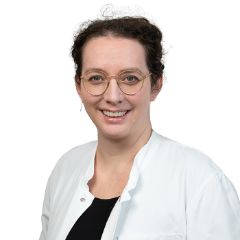
IMPACT study
Incidence of undiagnosed cervical myelopathy in elderly patients with hip fractures after falls - a prospective clinical study
Study start: 14.11.2022
Estimated study duration: 4 years
Aim of the study
Fractures near the hip joint are one of the most common and in some cases preventable causes of significant morbidity and mortality in older people (1,2). Due to the associated hospitalization and rehabilitation stays, fractures near the hip joint are associated with enormous costs for the healthcare system (3). Approximately 17% of affected patients spend the rest of their lives in a care facility, while mortality in the first year is around 20% (3,4,5).More than 80% of hip fractures occur in patients older than 75 years after a fall event (1,6) and more than 28% suffer a second fracture within the first 5 years (7,1). It is well known that falls are the most common cause of near-hip fractures, but very little research has been done into the potential risk factors.
Cervical spondylotic myelopathy (CSM; = spinal cord damage in the neck) is the most common spinal cord disease in the elderly (1), leading to gait instability which in turn causes falls. Studies have demonstrated that CSM leads to a doubling of dislocations and fractures in implanted hip endoprostheses (8). A small pilot study from 2016 showed an incidence of 18% for previously undiagnosed CSM in patients with fractures near the hip joint after a fall. However, the methodology had several shortcomings, particularly as 60% of patients could not be included and neither cervical spine imaging nor electrophysiological testing was performed. The authors summarized that a larger study with better evidence is urgently needed to determine whether screening for CSM and prophylactic treatment in older people with gait instability could reduce the risk of fractures near the hip joint (1).
The aim of the study is to detect the incidence of cervical spinal cord injury in patients >70 years of age with fall-related near-hip fractures in order to ultimately determine whether it makes sense to routinely screen elderly patients with gait instability for CSM and to treat them prophylactically.
References
1 Radcliff KE, Curry EP, Trimba R, et al. High Incidence of Undiagnosed Cervical Myelopathy in Patients With Hip Fracture Compared With Controls. J Orthop Trauma. 2016;30(4):189-193. doi:10.1097/BOT.0000000000000485
2 Fehlings MG, Skaf G. A review of the pathophysiology of cervical spondylotic myelopathy with insights for potential novel mechanisms drawn from traumatic spinal cord injury. Spine (Phila Pa 1976). 1998;23(24):2730-2737. doi:10.1097/00007632-199812150-00012
3 Sambrook P, Cooper C. Osteoporosis. Lancet. 2006;367(9527):2010-2018. doi:10.1016/S0140-6736(06)68891-0
4 Haentjens P. Meta-analysis: Excess Mortality After Hip Fracture Among Older Women and Men. Ann Intern Med. 2010;152(6):380. doi:10.7326/0003-4819-152-6-201003160-00008
5 Braithwaite RS, Col NF, Wong JB. Estimating Hip Fracture Morbidity, Mortality and Costs. Journal of the American Geriatrics Society. 2003;51(3):364-370. doi:10.1046/j.1532-5415.2003.51110.x
6. Tetreault LA, Kopjar B, Vaccaro A, et al. A clinical prediction model to determine outcomes in patients with cervical spondylotic myelopathy undergoing surgical treatment: data from the prospective, multi-center AOSpine North America study. J Bone Joint Surg Am. 2013;95(18):1659-1666. doi:10.2106/JBJS.L.01323
7 Lee JH, Lee SH, Seo IS. The characteristics of gait disturbance and its relationship with posterior tibial somatosensory evoked potentials in patients with cervical myelopathy. Spine (Phila Pa 1976). 2011;36(8):E524-530. doi:10.1097/BRS.0b013e3181f412d9
8 Blizzard DJ, Klement MR, Penrose CT, Sheets CZ, Bolognesi MP, Seyler TM. Cervical Myelopathy Doubles the Rate of Dislocation and Fracture After Total Hip Arthroplasty. J Arthroplasty. 2016;31(9 Suppl):242-247. doi:10.1016/j.arth.2016.05.070
Participation requirements
Patients older than 70 years who suffer a fracture near the hip joint after a fall and are treated at the University Hospital Basel are included.
Expenditure
The study participants will receive an MRI of the cervical spine during their inpatient stay in order to confirm/exclude CSM morphologically. Patients with proven CSM will then undergo a clinical neurological and electrophysiological examination (motor evoked potentials (MEP) and somatosensory evoked potentials (SSEP)) on an outpatient basis. As part of the outpatient check-up, affected patients are then advised by spinal surgeons regarding spinal cord decompression surgery with the aim of preventing further falls and counteracting progressive spinal cord damage.
Benefit
All examinations are free of charge for the study participants.
Risks
Study management
Principal Investigator

Sponsor Investigators


Co-Investigators

Prof. Norbert Suhm
Leitender Arzt/Zentrumsleiter Alterstraumazentrum
Orthopädie und Traumatologie
Leiter Alterstraumazentrum
Study design
A prospective interdisciplinary study of the Clinic for Spinal Surgery & Clinic for Orthopaedics and Traumatology of the Musculoskeletal System.
Student financing
- Gottfried and Julia Bangerter-Rhyner Foundation
-
Voluntary Academic Society (FAG) Basel
